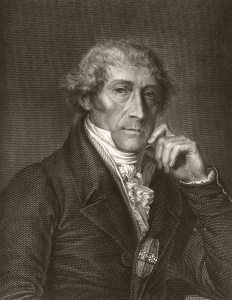Scarpa, Antonio
 Born in Lorenzaga di Motta di Livenza on the 19th of May 1752, Scarpa first studied at the University of Padua, where he graduated in Medicine in 1770. He was a favourite of Morgagni. Aged twenty years old, he became Anatomy professor in Modena, quickly gaining a name for himself for his research on ear structure and on ganglia (nerve cell clusters).
Born in Lorenzaga di Motta di Livenza on the 19th of May 1752, Scarpa first studied at the University of Padua, where he graduated in Medicine in 1770. He was a favourite of Morgagni. Aged twenty years old, he became Anatomy professor in Modena, quickly gaining a name for himself for his research on ear structure and on ganglia (nerve cell clusters).
In 1781, during a trip to Paris and London, he met surgeon Giovanni Brambilla, who hailed from the province of Pavia (San Zenone Po). This was a decisive moment in Scarpa’s professional path: Brambilla, who could count on Emperor Joseph II of Austria’s full trust, was able to secure him a position at Pavia University.
In Pavia, Scarpa immediately started the construction of a new and modern anatomical theatre.
Towards the end of the century, as political upheaval spread though Lombardy following Napoleon’s Northern Italy exploit, Scarpa demonstrated all the subtle tact of an experienced diplomat. Astutely navigating the difficult climate, he successfully maintained his position and power under both French and Austrian influence.
He was repeatedly elected President of the University, and in his final years was director of the Medicine Faculty as well as of the Anatomical Cabinets.
His work left a permanent mark in the fields of anatomy, surgery and ophthalmology. Scarpa’s ganglion (a small swelling along the vestibular nerve) and Scarpa’s secondary membrane of the eardrum are described in every anatomy text. Scarpa correctly described the secondary membrane’s function (“brings the collected vibrations transmitted by the eardrum towards the internal ear”) and the osseous labyrinth, as well as the membranous labyrinth with the endolymph (of which he is considered the discoverer). He also observed the membranous semi-circular ducts with their ampullas, the utricle and saccule.
Among his other anatomical acquisitions are the description of the olfactory bulb, of the nasopalatine nerve and of the heart innervation.
In the field of pathology, Scarpa is remembered for his studies on aneurism, on congenital clubfoot, on hernias (he was the first to precisely describe perineal hernias). He accurately described the triangular region crossed by the femoral artery, still known as the Scarpa Triangle, in his work on inguinal-femoral hernias.
